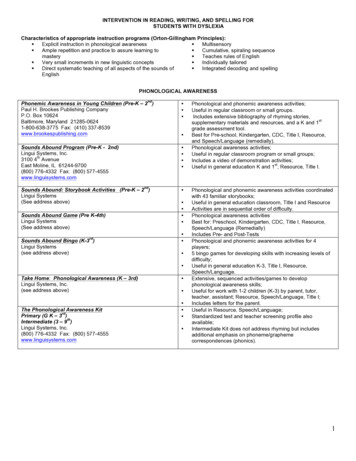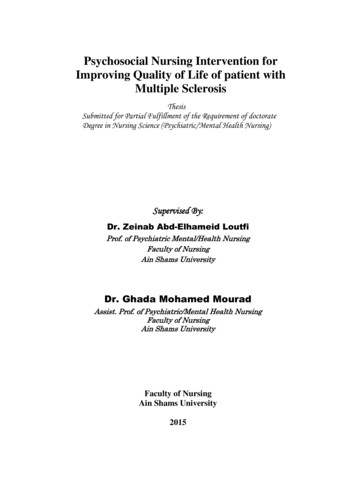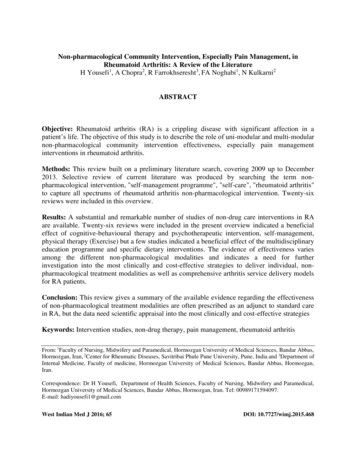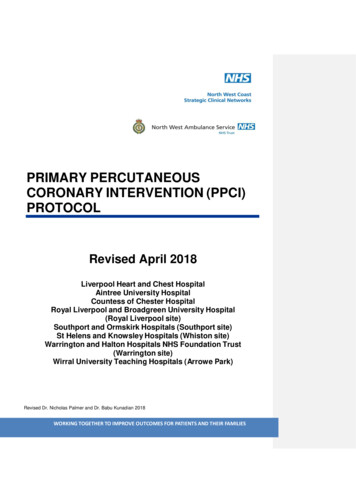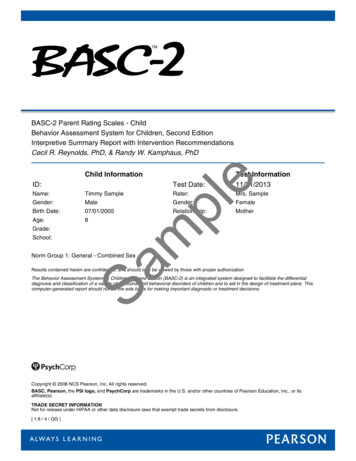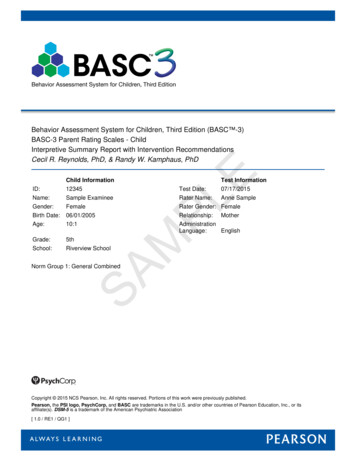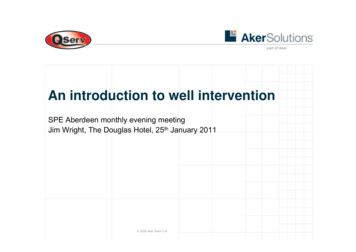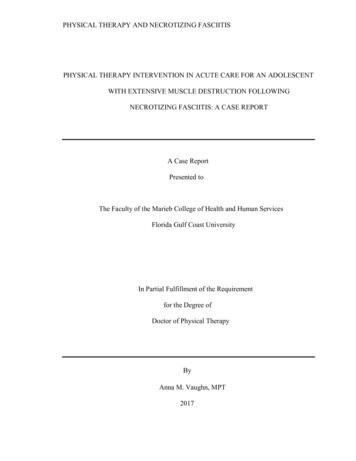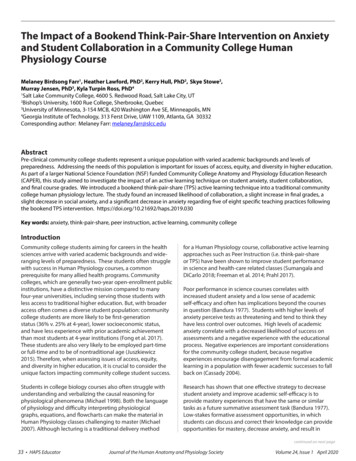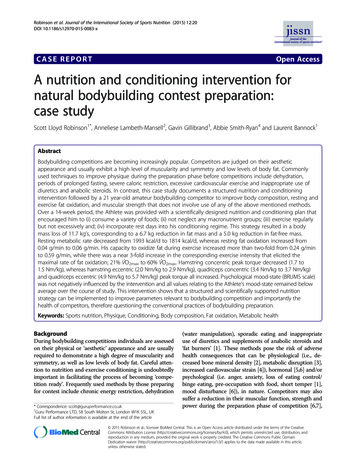
Transcription
Robinson et al. Journal of the International Society of Sports Nutrition (2015) 12:20DOI 10.1186/s12970-015-0083-xCASE REPORTOpen AccessA nutrition and conditioning intervention fornatural bodybuilding contest preparation:case studyScott Lloyd Robinson1*, Anneliese Lambeth-Mansell2, Gavin Gillibrand3, Abbie Smith-Ryan4 and Laurent Bannock1AbstractBodybuilding competitions are becoming increasingly popular. Competitors are judged on their aestheticappearance and usually exhibit a high level of muscularity and symmetry and low levels of body fat. Commonlyused techniques to improve physique during the preparation phase before competitions include dehydration,periods of prolonged fasting, severe caloric restriction, excessive cardiovascular exercise and inappropriate use ofdiuretics and anabolic steroids. In contrast, this case study documents a structured nutrition and conditioningintervention followed by a 21 year-old amateur bodybuilding competitor to improve body composition, resting andexercise fat oxidation, and muscular strength that does not involve use of any of the above mentioned methods.Over a 14-week period, the Athlete was provided with a scientifically designed nutrition and conditioning plan thatencouraged him to (i) consume a variety of foods; (ii) not neglect any macronutrient groups; (iii) exercise regularlybut not excessively and; (iv) incorporate rest days into his conditioning regime. This strategy resulted in a bodymass loss of 11.7 kg’s, corresponding to a 6.7 kg reduction in fat mass and a 5.0 kg reduction in fat-free mass.Resting metabolic rate decreased from 1993 kcal/d to 1814 kcal/d, whereas resting fat oxidation increased from0.04 g/min to 0.06 g/min. His capacity to oxidize fat during exercise increased more than two-fold from 0.24 g/minto 0.59 g/min, while there was a near 3-fold increase in the corresponding exercise intensity that elicited themaximal rate of fat oxidation; 21% V̇ O2max to 60% V̇ O2max. Hamstring concentric peak torque decreased (1.7 to1.5 Nm/kg), whereas hamstring eccentric (2.0 Nm/kg to 2.9 Nm/kg), quadriceps concentric (3.4 Nm/kg to 3.7 Nm/kg)and quadriceps eccentric (4.9 Nm/kg to 5.7 Nm/kg) peak torque all increased. Psychological mood-state (BRUMS scale)was not negatively influenced by the intervention and all values relating to the Athlete’s mood-state remained belowaverage over the course of study. This intervention shows that a structured and scientifically supported nutritionstrategy can be implemented to improve parameters relevant to bodybuilding competition and importantly thehealth of competitors, therefore questioning the conventional practices of bodybuilding preparation.Keywords: Sports nutrition, Physique, Conditioning, Body composition, Fat oxidation, Metabolic healthBackgroundDuring bodybuilding competitions individuals are assessedon their physical or ‘aesthetic’ appearance and are usuallyrequired to demonstrate a high degree of muscularity andsymmetry, as well as low levels of body fat. Careful attention to nutrition and exercise conditioning is undoubtedlyimportant in facilitating the process of becoming ‘competition ready’. Frequently used methods by those preparingfor contest include chronic energy restriction, dehydration* Correspondence: scott@guruperformance.co.uk1Guru Performance LTD, 58 South Molton St, London W1K 5SL, UKFull list of author information is available at the end of the article(water manipulation), sporadic eating and inappropriateuse of diuretics and supplements of anabolic steroids and‘fat burners’ [1]. These methods pose the risk of adversehealth consequences that can be physiological (i.e., decreased bone mineral density [2], metabolic disruption [3],increased cardiovascular strain [4]), hormonal [5,6] and/orpsychological (i.e. anger, anxiety, loss of eating control/binge eating, pre-occupation with food, short temper [1],mood disturbance [6]), in nature. Competitors may alsosuffer a reduction in their muscular function, strength andpower during the preparation phase of competition [6,7], 2015 Robinson et al.; licensee BioMed Central. This is an Open Access article distributed under the terms of the CreativeCommons Attribution License (http://creativecommons.org/licenses/by/4.0), which permits unrestricted use, distribution, andreproduction in any medium, provided the original work is properly credited. The Creative Commons Public DomainDedication waiver ) applies to the data made available in this article,unless otherwise stated.
Robinson et al. Journal of the International Society of Sports Nutrition (2015) 12:20Page 2 of 11as physique-oriented objectives are often placed above exercise performance and health goals.A case study approach has recently been used to outlineeffective support strategies for the achievement of bodycomposition and/or performance goals in professionalboxing [8], professional jockeying [9], and internationalstandard women’s football [10]. These examples highlightsports (especially boxing and horse riding) where athletesare required to repeatedly manipulate body compositionto compete and perform at the highest level, similar tobodybuilding preparation. Despite insightful studies thathave documented the physiological changes and dietarypractices [6,11,12] that occur during prolonged bodybuilding contest preparation, there have been no case studiesthat provide a detailed nutrition and conditioning supportstrategy for the preparation phase of natural bodybuildingcompetition. Accordingly, we present a 14-week casestudy demonstrating how a scientifically designed nutrition and conditioning intervention improves body composition, resting and exercise fat oxidation, and muscularstrength in an amateur bodybuilding competitor (referredto hereafter as ‘The Athlete’).Table 1 Example of foods consumed by the Athletebefore the interventionCase presentationMeal 6The AthleteWhey protein25Apple100The Athlete was a 21-year-old male amateur bodybuilderwho was aiming to compete in his first bodybuildingcompetition, UK Bodybuilding and Fitness Federation(UKBFF), in the Men’s Physique category. He had beenundertaking bodybuilding training for two years and hadnot previously sought any conditioning or dietary adviceother than that sourced from the Internet and popularfitness magazines. Furthermore, the Athlete was not onany prescribed medication, was a non-smoker and previously supplemented his diet with whey protein only. Inthe 3 months prior to the intervention his diet was identical on a daily basis; comprising of four meals and twosnacks that were high in carbohydrate and protein andvery low in fat (Table 1). In addition to the meals healready consumed, he incorporated one ‘cheat meal’ approximately every two weeks, which consisted of one largetake-away pizza and one serving ( 200 g) of ice cream.His conditioning regime consisted of six to seven days perweek of resistance training, focusing on individual musclegroups in each session (total nine hours per week).The Athlete was fully informed of the study aims andpotential risks and discomforts following which he provided written informed consent to participate in the studythat received full ethical approval from the University ofWorcester Ethics Committee.Goals of the interventionThe primary goals of the support provided were to:(a) achieve the best possible aesthetic appearance inItem/descriptionAmount (g)Meal 1Scrambled egg150Oats40 (dry)Meal 2Chicken breast170Broccoli150White rice40 (dry)Meal 3Whey protein50Meal 4Chicken breast170White rice40 (dry)Sweet potato150Meal 5Chicken breast170White rice40 (dry)Sweet potato150TotalsEnergy (kcal)2128Carbohydrate (g)212Fat (g)28Protein (g)257preparation for UKBFF; (b) improve resting and exercise fat oxidation; (c) preserve muscular function andstrength; (d) maintain a positive mood-state during the14-week lead in to competition.Metabolic assessmentResting Metabolic Rate Assessment (RMR) was determined on six occasions (Familiarization, Baseline, Week 3,Week 8, Week 10 and Week 13) and a graded ExerciseTest was completed on three occasions (Familiarization,Baseline and Week 13) to determine rates of fat oxidatioṅ O2max). Forduring exercise and cardiorespiratory fitness (Vall assessments the Athlete reported to the laboratory at07:00 h following an overnight fast from 10 pm the evening before and having abstained from strenuous physicalactivity, alcohol and caffeine consumption in the 24 h preceding each visit. The Athlete was asked not to performany physical activity on the morning of testing, such asbrisk walking or cycling to the laboratory, and to consume500 ml water upon waking to encourage hydration. The
Robinson et al. Journal of the International Society of Sports Nutrition (2015) 12:20Athlete was fitted with a facemask for both the RMR andExercise Testing (Combitox, Drager, Jaeger, NussdorfTraunstein, Germany) and breath-by-breath measurė O2) and carbon dioxidements of oxygen consumption (V̇production (VCO2) were measured continuously usingan online gas analysis system (Oxycon Pro, Jaeger,Wuerzberg, Germany). The gas analyzer was calibratedimmediately prior to testing with a known gas concentration (5% CO2; 16% O2; 79% N2 [BOC Gases, Surrey,UK]) and a three-liter calibration syringe (Hans Rudolf,USA) was used to calibrate the volume transducer.Environmental conditions during testing were: humidity51 6%; temperature 20 1 C.For the RMR Assessment the Athlete was required tolie still on a bed in the supine position for 30 minutes ina dimly lit room. There was no visual or auditory stimulation throughout this period. The Exercise Test was completed 15 minutes after the RMR assessment. This wasbased on the protocol described previously by Achten andcolleagues [13] with the starting speed and inclination ofthe treadmill (HP Cosmos, Jaeger, Nussdorf Traunstein,Germany) set at 3.5 km/h and 1%, respectively. The treadmill speed was increased by 1 km/h every three minutesuntil the respiratory exchange ratio (RER) reached 1.00. Atthis point the treadmill gradient was increased by 1% everyminute until volitional exhaustion. Heart rate was measured continuously throughout testing using a heart ratemonitor (Polar FT-1, Finland) and was recorded duringthe final 30 seconds of each exercise stage.CalculationsResting energy expenditure and fat oxidation were calculated during a stable measurement period i.e., a devi̇ O2 of 10% of the average V̇ O2 betweenation in Vminutes 20–30 (mean SD recording period was 5 2 minutes) using the equations of Frayn [14] and a protein correction factor of 0.11 mg/kg/min, as used prė O2 andviously [15,16]. During the Exercise Test V̇VCO2 were averaged over the last minute of each submaximal exercise stage and fat and carbohydrate oxidation were calculated according to the equations ofFrayn [14], with the assumption that the urinary nitrȯ O2 was consideredgen excretion rate was negligible. Vas maximal when two of the following three criteriawere met; an RER 1.1, heart rate within 10 beats ofpredicted maximum (calculated as 220-age [17]), or aṅ O2 with a further inincrease of 2 ml/kg/min in V̇crease in workload. VO2max was calculated as the higḣ O2. The results of theest rolling 60 second average VExercise Test were used to create a curve of fat oxidatioṅ O2max. Therate against exercise intensity, expressed as% Vmaximal rate of fat oxidation during exercise (MFO) wasdetermined by visual inspection i.e., by judging the peak ofthe curve and its corresponding rate of fat oxidation.Page 3 of 11̇ O2max)Fatmax was defined as the exercise intensity (%Vthat corresponded to MFO, as described previously [18].Diet and activity recordingsAt Baseline, the Athlete was provided with two sets ofdigital weighing scales (Electronic Kitchen Scale SF 400and Swees Digital Pocket Weighing Scales); blank fourday diet log and physical activity diaries; and detailed instructions to enable the completion of these at week 3,6, 10 and 12. The Athlete was instructed to record allconsumed food and drink items accurately and in asmuch detail as possible. The activity diary was based onBouchard et al. [19] and required the Athlete to recordlevel-of-activity every 15 minutes, using a code from a12-point scale (provided). The diary was completed over a24-hour period on each of the four days. The scale rangedfrom ‘sleeping’ to ‘vigorous exercise’ and provided examples of activities at each point to assist the Athlete. To ensure the highest possible level of accuracy in estimationsof energy expenditure, he was encouraged to make noteson any sport or exercise performed during the four dayssampled. Diet logs were analyzed using Nutritics dietaryanalysis software (Nutritics v3.06, Ireland).Daily energy expenditure was estimated using the factorial approach [20]. Here, each of the 12 codes, whichhad a corresponding metabolic equivalent (MET) value,was assigned a Physical Activity Level (PAL) [21] and adaily PAL was determined by multiplying each of the 12codes by the total amount of time spent at the activitylevel. Where he had made notes on a specific sport andexercise activity undertaken during the 4 days, theCompendium of Physical Activities [22] was used to calculate the specific PAL value. Daily energy expenditurewas then estimated by multiplying the daily PAL valueby the age and sex specific resting metabolic rate (RMR;kcal/d) using height, weight and the World HealthOrganization (WHO) equation [23]:Energy Expenditureðkcal d; men 30 yearsÞ: Daily PAL value RMRð15:4 body mass½kg Þ ð27:0 height½m Þ þ 717ÞAnthropometric assessmentBaseline assessments are shown in Table 2. Height(Stadiometer, Seca, UK), mass (Seca, UK) and bodycomposition using skin-folds and girths (measured byan International Standards for Anthropometric Assessment (ISAK) Certified Anthropometrist) were assessed atBaseline and at Weeks 3, 5, 7, 10, 12, 13 and 14 of theintervention at a standardized time of
ously supplemented his diet with whey protein only. In the 3 months prior to the intervention his diet was identi-cal on a daily basis; comprising of four meals and two snacks that were high in carbohydrate and protein and very low in fat (Table 1). In addition to the meals he
